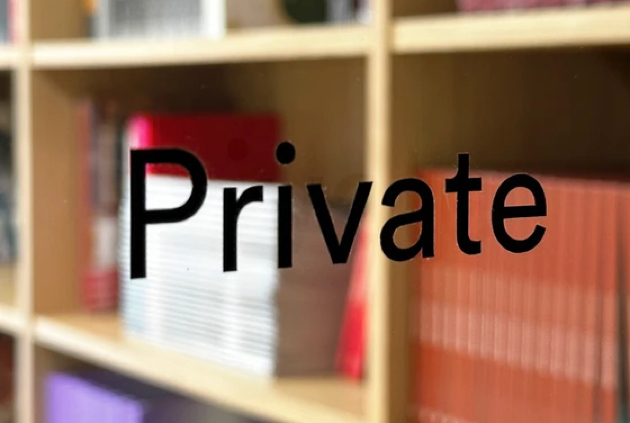Tod Lippy's "Private" at The Meeting, April 10 - May 11, 2024.
Privacy isn’t what it used to be. Sharing, perhaps oversharing, one’s life, live in real-time, through images and videos has changed how we present ourselves to the world and how others interpret an individual’s social engagements. What were once private, frequently intimate, moments are now seemingly a required “proof of life” to be shared openly via social media. The elliptical act of placing a life on view validates, and reassures, social media users that they are participating in a social structure, if it generates a “like” then it must be worth doing. In the interconnected world today, the sharing of images, correspondence, and personally identifying data with, or without, consent should temper, but frequently does not, all modes of communication.
Galleries and museums are now an acute locus of focus where artworks have become the background for the framing of selfies. It doesn’t take much effort to imagine somebody, cell phone in hand, taking one too many steps backwards at The Museum of Modern Art and breaking one of the fluorescent tubes of Dan Flavin’s
untitled (to the "innovator" of Wheeling Peachblow), 1968. Which is something that has happened with regularity at the museum.
The dichotomy between public and private was long thought to be cleanly divided between two walled gardens. In 1929 Henry Stimson, the Secretary of State during the administration of President Herbert Hoover, went so far as terminating the government’s Cipher Bureau—established 10 years earlier, during World War I—stating, no doubt in a proper patrician tone of authority,
“Gentlemen do not read each others’ mail.”
Within both of these natures, commercial galleries from the mid-tier to the mega-galleries operate with one foot in the public sphere and the other behind a door marked “private.”
In 1988 the New York City Department of Consumer Affairs, which governs among other things retail sales, began to “enforce a city law requiring the price of paintings and sculptures in art galleries to be ‘conspicuously displayed’ within sight of customers.”(1) In a rare moment of artworld transparency prices for works of art began to publicly appear, frequently begrudgingly in inconspicuous places, in galleries in the city. The New York Times noted, “At the Mary Boone Gallery, for instance, a price list is taped to the countertop in the back office. Visitors who want to look at the list must climb two steps and lean over a red velvet rope that hangs across the doorway, separating the gallery from the office."
"‘The people who are seriously involved don't even look at this,’ Ms. Boone said, pointing to the price list for paintings by the young artist David Salle (prices: $90,000 to $150,000). ‘It makes the whole emphasis of the art world wrong.'"(2)
Right or wrong, making financial information public faded from display as the city curtailed enforcing the law outside of auction houses. Today, asking a front desk worker at the gallery about prices of works on display typically results in a shrug, or a curt retort informing a visitor that a salesperson would need to be called for such details, leaving pricing for the general public opaque. Here, the cliché, “If you need to ask, you can’t afford it,” is more than operable.
Art dealing, historically, has been a gentleman’s business. Namely, gentlemen dealers selling art made by gentlemen artists to wealthy gentlemen. While there’s been an accelerating diversification of all three circles of this three-ring circus, the actual business of buying and selling remains behind literal and physically closed doors.
As the dimensions of art dealing began to expand dynamically in the 1990s – by the square footage of architect-designed spaces and gross sales – sales of secondary market artworks, once dominated by auction houses, shifted towards the back rooms of galleries. In these private spaces in private galleries, private sales of privately held art have become the backbone of the economics fueling the operations of these businesses.
Those spaces are the subject of
Tod Lippy's photographs, taken surreptitiously by the artist for the past five or so years. His images depict closed (and sometimes, partially open) doors sporting the word “
Private,” as well as off-limits areas demarcated by velvet ropes, chains, and other barriers to entry. These mysterious areas—the mullets of the artworld, business up front, party in the back—suggest unimaginable loot, offered privately to those intrepid enough to be afforded entry by privateers.
—David Platzker
(1)
Douglas C. McGill, "Art Galleries Told to Post Prices," The New York Times, February 10, 1988.
(2)
Douglas C. McGill, "About Posting Prices, but Browsers Like It," The New York Times, March 14, 1988.
